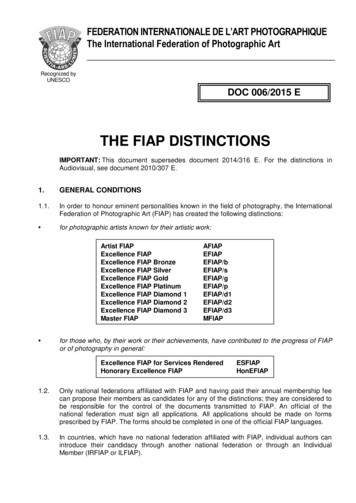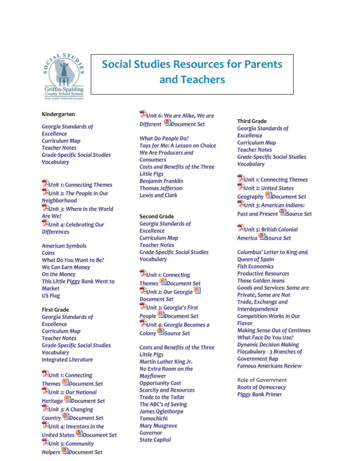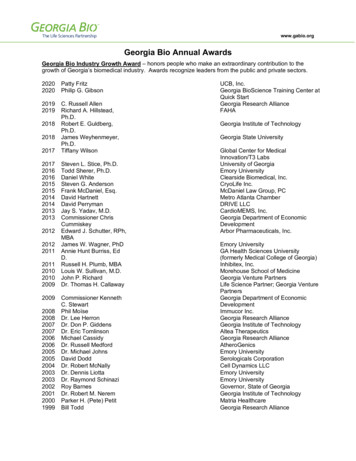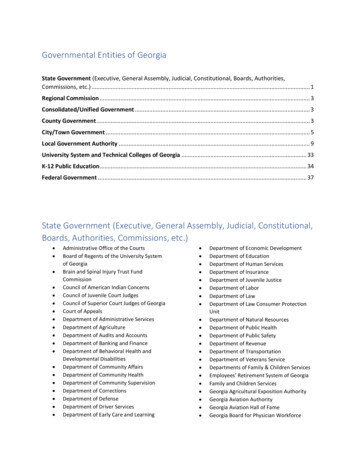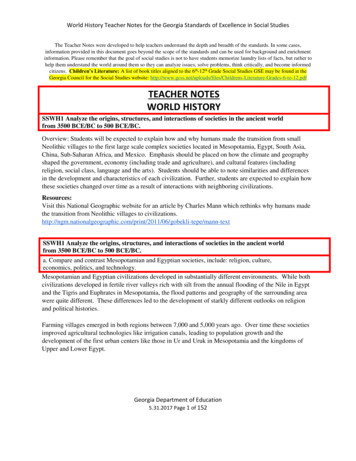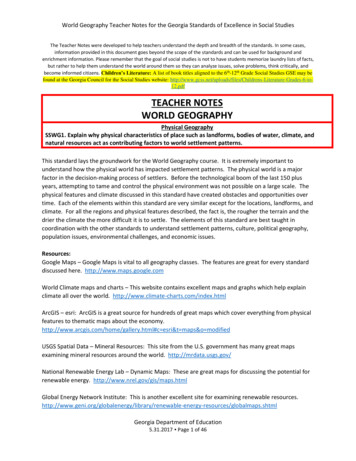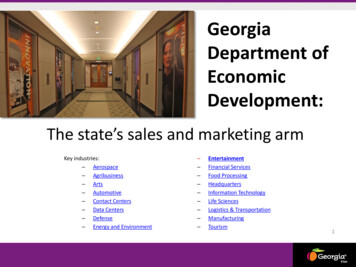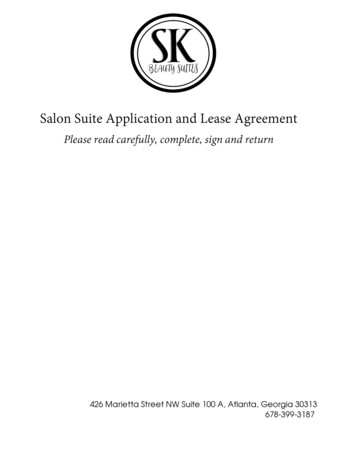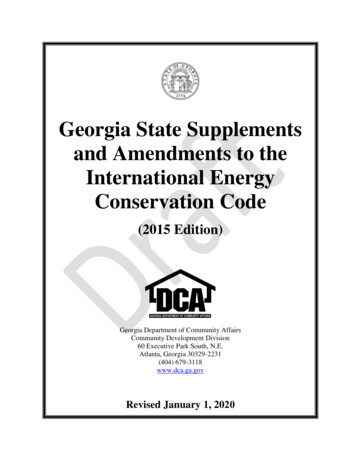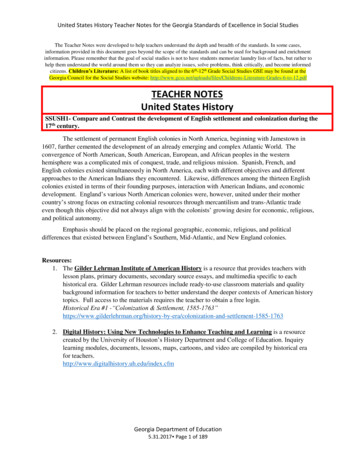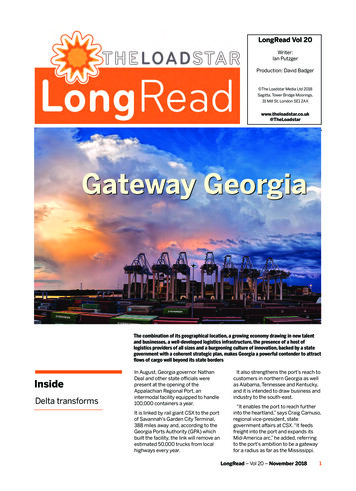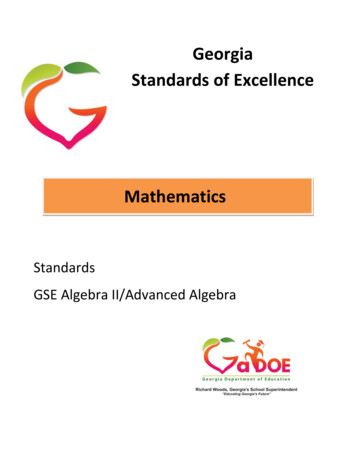
Transcription
GeorgiaStandards of ExcellenceMathematicsStandardsGSE Algebra II/Advanced Algebra
Georgia Department of EducationK-12 Mathematics IntroductionGeorgia Mathematics focuses on actively engaging the student in the development of mathematicalunderstanding by working independently and cooperatively to solve problems, estimating and computingefficiently, using appropriate tools, concrete models and a variety of representations, and conductinginvestigations and recording findings. There is a shift toward applying mathematical concepts and skills in thecontext of authentic problems and student understanding of concepts rather than merely following a sequence ofprocedures. In mathematics classrooms, students will learn to think critically in a mathematical way with anunderstanding that there are many different solution pathways and sometimes more than one right answer inapplied mathematics. Mathematics is the economy of information. The central idea of all mathematics is todiscover how knowing some things leads, via reasoning, to knowing more—without having to commit theinformation to memory as a separate fact. It is the reasoned, logical connections that make mathematicscoherent. The implementation of the Georgia Standards of Excellence in Mathematics places the expectedemphasis on sense-making, problem solving, reasoning, representation, modeling, representation, connections,and communication.Algebra II/Advanced AlgebraAlgebra II/Advanced Algebra is the culminating course in a sequence of three high school courses designed toensure career and college readiness. It is designed to prepare students for fourth course options relevant to theircareer pursuits.The standards in the three-course high school sequence specify the mathematics that all students should study inorder to be college and career ready. Additional mathematics content is provided in fourth credit courses andadvanced courses including pre-calculus, calculus, advanced statistics, discrete mathematics, and mathematicsof finance courses. High school course content standards are listed by conceptual categories including Numberand Quantity, Algebra, Functions, Geometry, and Statistics and Probability. Conceptual categories portray acoherent view of high school mathematics content; a student’s work with functions, for example, crosses anumber of traditional course boundaries, potentially up through and including calculus. Standards forMathematical Practice provide the foundation for instruction and assessment.Mathematics Standards for Mathematical PracticeMathematical Practices are listed with each grade’s mathematical content standards to reflect theneed to connect the mathematical practices to mathematical content in instruction.The Standards for Mathematical Practice describe varieties of expertise that mathematics educators at all levelsshould seek to develop in their students. These practices rest on important “processes and proficiencies” withlongstanding importance in mathematics education. The first of these are the NCTM process standards ofproblem solving, reasoning and proof, communication, representation, and connections. The second are thestrands of mathematical proficiency specified in the National Research Council’s report Adding It Up: adaptivereasoning, strategic competence, conceptual understanding (comprehension of mathematical concepts,operations and relations), procedural fluency (skill in carrying out procedures flexibly, accurately, efficientlyand appropriately), and productive disposition (habitual inclination to see mathematics as sensible, useful, andworthwhile, coupled with a belief in diligence and one’s own efficacy).Richard Woods, State School SuperintendentJuly 2016 Page 2 of 10All Rights Reserved
Georgia Department of Education1 Make sense of problems and persevere in solving them.High school students start to examine problems by explaining to themselves the meaning of a problem andlooking for entry points to its solution. They analyze givens, constraints, relationships, and goals. They makeconjectures about the form and meaning of the solution and plan a solution pathway rather than simply jumpinginto a solution attempt. They consider analogous problems, and try special cases and simpler forms of theoriginal problem in order to gain insight into its solution. They monitor and evaluate their progress and changecourse if necessary. Older students might, depending on the context of the problem, transform algebraicexpressions or change the viewing window on their graphing calculator to get the information they need. Byhigh school, students can explain correspondences between equations, verbal descriptions, tables, and graphs ordraw diagrams of important features and relationships, graph data, and search for regularity or trends. Theycheck their answers to problems using different methods and continually ask themselves, “Does this makesense?” They can understand the approaches of others to solving complex problems and identifycorrespondences between different approaches.2 Reason abstractly and quantitatively.High school students seek to make sense of quantities and their relationships in problem situations. Theyabstract a given situation and represent it symbolically, manipulate the representing symbols, and pause asneeded during the manipulation process in order to probe into the referents for the symbols involved. Studentsuse quantitative reasoning to create coherent representations of the problem at hand; consider the units involved;attend to the meaning of quantities, not just how to compute them; and know and flexibly use differentproperties of operations and objects.3 Construct viable arguments and critique the reasoning of others.High school students understand and use stated assumptions, definitions, and previously established results inconstructing arguments. They make conjectures and build a logical progression of statements to explore the truthof their conjectures. They are able to analyze situations by breaking them into cases, and can recognize and usecounterexamples. They justify their conclusions, communicate them to others, and respond to the arguments ofothers. They reason inductively about data, making plausible arguments that take into account the context fromwhich the data arose. High school students are also able to compare the effectiveness of two plausiblearguments, distinguish correct logic or reasoning from that which is flawed, and—if there is a flaw in anargument—explain what it is. High school students learn to determine domains to which an argument applies,listen or read the arguments of others, decide whether they make sense, and ask useful questions to clarify orimprove the arguments.4 Model with mathematics.High school students can apply the mathematics they know to solve problems arising in everyday life, society,and the workplace. By high school, a student might use geometry to solve a design problem or use a function todescribe how one quantity of interest depends on another. High school students making assumptions andapproximations to simplify a complicated situation, realizing that these may need revision later. They are able toidentify important quantities in a practical situation and map their relationships using such tools as diagrams,two-way tables, graphs, flowcharts and formulas. They can analyze those relationships mathematically to drawconclusions. They routinely interpret their mathematical results in the context of the situation and reflect onwhether the results make sense, possibly improving the model if it has not served its purpose.Richard Woods, State School SuperintendentJuly 2016 Page 3 of 10All Rights Reserved
Georgia Department of Education5 Use appropriate tools strategically.High school students consider the available tools when solving a mathematical problem. These tools mightinclude pencil and paper, concrete models, a ruler, a protractor, a calculator, a spreadsheet, a computer algebrasystem, a statistical package, or dynamic geometry software. High school students should be sufficientlyfamiliar with tools appropriate for their grade or course to make sound decisions about when each of these toolsmight be helpful, recognizing both the insight to be gained and their limitations. For example, high schoolstudents analyze graphs of functions and solutions generated using a graphing calculator. They detect possibleerrors by strategically using estimation and other mathematical knowledge. When making mathematical models,they know that technology can enable them to visualize the results of varying assumptions, exploreconsequences, and compare predictions with data. They are able to identify relevant external mathematicalresources, such as digital content located on a website, and use them to pose or solve problems. They are able touse technological tools to explore and deepen their understanding of concepts.6 Attend to precision. High school students try to communicate precisely to others by using clear definitions indiscussion with others and in their own reasoning. They state the meaning of the symbols they choose,specifying units of measure, and labeling axes to clarify the correspondence with quantities in a problem. Theycalculate accurately and efficiently, express numerical answers with a degree of precision appropriate for theproblem context. By the time they reach high school they have learned to examine claims and make explicit useof definitions.7 Look for and make use of structure. By high school, students look closely to discern a pattern or structure.In the expression x2 9x 14, older students can see the 14 as 2 7 and the 9 as 2 7. They recognize thesignificance of an existing line in a geometric figure and can use the strategy of drawing an auxiliary line forsolving problems. They also can step back for an overview and shift perspective. They can see complicatedthings, such as some algebraic expressions, as single objects or as being composed of several objects. Forexample, they can see 5 – 3(x – y)2 as 5 minus a positive number times a square and use that to realize that itsvalue cannot be more than 5 for any real numbers x and y. High school students use these patterns to createequivalent expressions, factor and solve equations, and compose functions, and transform figures.8 Look for and express regularity in repeated reasoning.High school students notice if calculations are repeated, and look both for general methods and for shortcuts.Noticing the regularity in the way terms cancel when expanding (x – 1)(x 1), (x – 1)(x2 x 1), and (x – 1)(x3 x2 x 1) might lead them to the general formula for the sum of a geometric series. As they work to solve aproblem, derive formulas or make generalizations, high school students maintain oversight of the process, whileattending to the details. They continually evaluate the reasonableness of their intermediate results.Connecting the Standards for Mathematical Practice to the Standards for Mathematical ContentThe Standards for Mathematical Practice describe ways in which developing student practitioners of thediscipline of mathematics should engage with the subject matter as they grow in mathematical maturity andexpertise throughout the elementary, middle and high school years. Designers of curricula, assessments, andprofessional development should all attend to the need to connect the mathematical practices to mathematicalcontent in mathematics instruction.The Standards for Mathematical Content are a balanced combination of procedure and understanding.Expectations that begin with the word “understand” are often especially good opportunities to connect theRichard Woods, State School SuperintendentJuly 2016 Page 4 of 10All Rights Reserved
Georgia Department of Educationpractices to the content. Students who do not have an understanding of a topic may rely on procedures tooheavily. Without a flexible base from which to work, they may be less likely to consider analogous problems,represent problems coherently, justify conclusions, apply the mathematics to practical situations, use technologymindfully to work with the mathematics, explain the mathematics- accurately to other students, step back for anoverview, or deviate from a known procedure to find a shortcut. In short, a lack of understanding effectivelyprevents a student from engaging in the mathematical practices.In this respect, those content standards which set an expectation of understanding are potential “points ofintersection” between the Standards for Mathematical Content and the Standards for Mathematical Practice.These points of intersection are intended to be weighted toward central and generative concepts in the schoolmathematics curriculum that most merit the time, resources, innovative energies, and focus necessary toqualitatively improve the curriculum, instruction, assessment, professional development, and studentachievement in mathematics.Algebra II/Advanced Algebra Content StandardsThe Real Number SystemN.RNExtend the properties of exponents to rational exponents.MGSE9-12.N.RN.1. Explain how the meaning of rational exponents follows from extending the properties ofinteger exponents to rational numbers, allowing for a notation for radicals in terms of rational exponents. Forexample, we define 5(1/3) to be the cube root of 5 because we want [5(1/3)] 3 5[(1/3) x 3] to hold, so [5(1/3)] 3 mustequal 5.MGSE9-12.N.RN.2 Rewrite expressions involving radicals and rational exponents using the properties ofexponents.The Complex Number SystemN.CNPerform arithmetic operations with complex numbers.MGSE9-12.N.CN.1 Understand there is a complex number i such that i2 1, and every complex number hasthe form a bi where a and b are real numbers.MGSE9-12.N.CN.2 Use the relation i2 –1 and the commutative, associative, and distributive properties toadd, subtract, and multiply complex numbers.MGSE9-12.N.CN.3 Find the conjugate of a complex number; use the conjugate to find the absolute value(modulus) and quotient of complex numbers.Use complex numbers in polynomial identities and equations.MGSE9-12.N.CN.7 Solve quadratic equations with real coefficients that have complex solutions by (but notlimited to) square roots, completing the square, and the quadratic formula.MGSE9-12.N.CN.8 Extend polynomial identities to include factoring with complex numbers. For example,rewrite x2 4 as (x 2i)(x – 2i).Richard Woods, State School SuperintendentJuly 2016 Page 5 of 10All Rights Reserved
Georgia Department of EducationMGSE9-12.N.CN.9 Use the Fundamental Theorem of Algebra to find all roots of a polynomial equation.Seeing Structure in ExpressionsA.SSEInterpret the structure of expressionsMGSE9-12.A.SSE.1 Interpret expressions that represent a quantity in terms of its context.MGSE9-12.A.SSE.1a Interpret parts of an expression, such as terms, factors, and coefficients, in context.MGSE9-12.A.SSE.1b Given situations which utilize formulas or expressions with multiple terms and/orfactors, interpret the meaning (in context) of individual terms or factors.MGSE9-12.A.SSE.2 Use the structure of an expression to rewrite it in different equivalent forms. For example,see x4 – y4 as (x2)2 - (y2)2, thus recognizing it as a difference of squares that can be factored as (x2 – y2) (x2 y2).Write expressions in equivalent forms to solve problemsMGSE9-12.A.SSE.3 Choose and produce an equivalent form of an expression to reveal and explain propertiesof the quantity represented by the expression.MGSE9-12.A.SSE.3c Use the properties of exponents to transform expressions for exponential functions.For example, the expression 1.15t , where t is in years, can be rewritten as [1.15(1/12)] (12t) 1.012(12t) toreveal the approximate equivalent monthly interest rate if the annual rate is 15%.MGSE9-12.A.SSE.4 Derive the formula for the sum of a finite geometric series (when the common ratio isnot 1), and use the formula to solve problems. For example, calculate mortgage payments.Arithmetic with Polynomials and Rational ExpressionsA.APRPerform arithmetic operations on polynomialsMGSE9-12.A.APR.1 Add, subtract, and multiply polynomials; understand that polynomials form a systemanalogous to the integers in that they are closed under these operations.Understand the relationship between zeros and factors of polynomialsMGSE9-12.A.APR.2 Know and apply the Remainder Theorem: For a polynomial p(x) and a number a, theremainder on division by x – a is p(a), so p(a) 0 if and only if (x – a) is a factor of p(x).MGSE9-12.A.APR.3 Identify zeros of polynomials when suitable factorizations are available, and use the zerosto construct a rough graph of the function defined by the polynomial.Use polynomial identities to solve problemsMGSE9-12.A.APR.4 Prove polynomial identities and use them to describe numerical relationships. Forexample, the polynomial identity (x2 y2)2 (x2 – y2)2 (2xy)2 can be used to generate Pythagorean triples.Richard Woods, State School SuperintendentJuly 2016 Page 6 of 10All Rights Reserved
Georgia Department of EducationMGSE9-12.A.APR.5 Know and apply that the Binomial Theorem gives the expansion of (x y) n in powers ofx and y for a positive integer n, where x and y are any numbers, with coefficients determined using Pascal’sTriangle.Rewrite rational expressionsMGSE9-12.A.APR.6 Rewrite simple rational expressions in different forms using inspection, long division, ora computer algebra system; write a(x)/b(x) in the form q(x) r(x)/b(x), where a(x), b(x), q(x), and r(x) arepolynomials with the degree of r(x) less than the degree of b(x).MGSE9-12.A.APR.7 Understand that rational expressions form a system analogous to the rational numbers,closed under addition, subtraction, multiplication, and division by a nonzero rational expression; add, subtract,multiply, and divide rational expressions.Creating EquationsA.CEDCreate equations that describe numbers or relationshipsMGSE9-12.A.CED.1 Create equations and inequalities in one variable and use them to solve problems. Includeequations arising from linear, quadratic, simple rational, and exponential functions (integer inputs only).MGSE9-12.A.CED.2 Create linear, quadratic, and exponential equations in two or more variables to representrelationships between quantities; graph equations on coordinate axes with labels and scales. (The phrase “in twoor more variables” refers to formulas like the compound interest formula, in which A P(1 r/n)nt hasmultiple variables.)MGSE9-12.A.CED.3 Represent constraints by equations or inequalities, and by systems of equation and/orinequalities, and interpret data points as possible (i.e. a solution) or not possible (i.e. a non-solution) under theestablished constraints.MGSE9-12.A.CED.4 Rearrange formulas to highlight a quantity of interest using the same reasoning as insolving equations. Examples: Rearrange Ohm’s law V IR to highlight resistance R; Rearrange area of acircle formula A π r2 to highlight the radius r.Reasoning with Equations and InequalitiesA.REIUnderstand solving equations as a process of reasoning and explain the reasoningMGSE9-12.A.REI.2 Solve simple rational and radical equations in one variable, and give examples showinghow extraneous solutions may arise.Solve equations and inequalities in one variableMGSE9-12.A.REI.4 Solve quadratic equations in one variable.MGSE9-12.A.REI.4b Solve quadratic equations by inspection (e.g., for x2 49), taking square roots,factoring, completing the square, and the quadratic formula, as appropriate to the initial form of the equation(limit to real number solutions).Richard Woods, State School SuperintendentJuly 2016 Page 7 of 10All Rights Reserved
Georgia Department of EducationRepresent and solve equations and inequalities graphicallyMGSE9-12.A.REI.11 Using graphs, tables, or successive approximations, show that the solution to theequation f(x) g(x) is the x-value where the y-values of f(x) and g(x) are the same.Interpreting FunctionsF.IFInterpret functions that arise in applications in terms of the contextMGSE9-12.F.IF.4 Using tables, graphs, and verbal descriptions, interpret the key characteristics of a functionwhich models the relationship between two quantities. Sketch a graph showing key features including:intercepts; interval where the function is increasing, decreasing, positive, or negative; relative maximums andminimums; symmetries; end behavior; and periodicity.MGSE9-12.F.IF.5 Relate the domain of a function to its graph and, where applicable, to the quantitativerelationship it describes. For example, if the function h(n) gives the number of person-hours it takes to assemblen engines in a factory, then the positive integers would be an appropriate domain for the function.MGSE9-12.F.IF.6 Calculate and interpret the average rate of change of a function (presented symbolically or asa table) over a specified interval. Estimate the rate of change from a graph.Analyze functions using different representationsMGSE9-12.F.IF.7 Graph functions expressed algebraically and show key features of the graph both by handand by using technology.MGSE9-12.F.IF.7b Graph square root, cube root, and piecewise-defined functions, including step functionsand absolute value functions.MGSE9-12.F.IF.7c Graph polynomial functions, identifying zeros when suitable factorizations areavailable, and showing end behavior.MGSE9-12.F.IF.7d Graph rational functions, identifying zeros and asymptotes when suitable factorizationsare available, and showing end behavior.MGSE9-12.F.IF.7e Graph exponential and logarithmic functions, showing intercepts and end behavior, andtrigonometric functions, showing period, midline, and amplitude.MGSE9-12.F.IF.8 Write a function defined by an expression in different but equivalent forms to reveal andexplain different properties of the function.MGSE9-12.F.IF.8b Use the properties of exponents to interpret expressions for exponential functions. Forexample, identify percent rate of change in functions such as y (1.02)t, y (0.97)t, y (1.01)(12t), y (1.2)(t/10), and classify them as representing exponential growth and decay.MGSE9-12.F.IF.9 Compare properties of two functions each represented in a different way (algebraically,graphically, numerically in tables, or by verbal descriptions). For example, given a graph of one function and analgebraic expression for another, say which has the larger maximum.Richard Woods, State School SuperintendentJuly 2016 Page 8 of 10All Rights Reserved
Georgia Department of EducationBuilding FunctionsF.BFBuild a function that models a relationship between two quantitiesMGSE9-12.F.BF.1 Write a function that describes a relationship between two quantities.MGSE9-12.F.BF.1b Combine standard function types using arithmetic operations in contextual situations(Adding, subtracting, and multiplying functions of different types).MGSE9-12.F.BF.1c Compose functions. For example, if T(y) is the temperature in the atmosphere as afunction of height, and h(t) is the height of a weather balloon as a function of time, then T(h(t)) is thetemperature at the location of the weather balloon as a function of time.Build new functions from existing functionsMGSE9-12.F.BF.3 Identify the effect on the graph of replacing f(x) by f(x) k, k f(x), f(kx), and f(x k) forspecific values of k (both positive and negative); find the value of k given the graphs. Experiment with casesand illustrate an explanation of the effects on the graph using technology. Include recognizing even and oddfunctions from their graphs and algebraic expressions for them.MGSE9-12.F.BF.4 Find inverse functions.MGSE9-12.F.BF.4a Solve an equation of the form f(x) c for a simple function f that has an inverse andwrite an expression for the inverse. For example, f(x) 2(x3) or f(x) (x 1)/(x-1) for x 1.MGSE9-12.F.BF.4b Verify by composition that one function is the inverse of another.MGSE9-12.F.BF.4c Read values of an inverse function from a graph or a table, given that the function hasan inverse.MGSE9-12.F.BF.5 Understand the inverse relationship between exponents and logarithms and use thisrelationship to solve problems involving logarithms and exponents.Linear, Quadratic, and Exponential ModelsF.LEConstruct and compare linear, quadratic, and exponential models and solve problemsMGSE9-12.F.LE.4 For exponential models, express as a logarithm the solution to ab(ct) d where a, c, and dare numbers and the base b is 2, 10, or e; evaluate the logarithm using technology.Interpreting Categorical and Quantitative DataS.IDSummarize, represent, and interpret data on a single count or measurement variableMGSE9-12.S.ID.2 Use statistics appropriate to the shape of the data distribution to compare center (median,mean) and spread (interquartile range, mean absolute deviation, standard deviation) of two or more differentdata sets.MGSE9-12.S.ID.4 Use the mean and standard deviation of a data set to fit it to a normal distribution and toestimate population percentages. Recognize that there are data sets for which such a procedure is notappropriate. Use calculators, spreadsheets, and tables to estimate areas under the normal curve.Richard Woods, State School SuperintendentJuly 2016 Page 9 of 10All Rights Reserved
Georgia Department of EducationMaking Inferences and Justifying ConclusionsS.ICUnderstand and evaluate random processes underlying statistical experimentsMGSE9-12.S.IC.1 Understand statistics as a process for making inferences about population parameters basedon a random sample from that population.MGSE9-12.S.IC.2 Decide if a specified model is consistent with results from a given data-generating process,e.g., using simulation. For example, a model says a spinning coin falls heads up with probability 0. 5. Would aresult of 5 tails in a row cause you to question the model?Make inferences and justify conclusions from sample surveys, experiments, and observational studiesMGSE9-12.S.IC.3 Recognize the purposes of and differences among sample surveys, experiments, andobservational studies; explain how randomization relates to each.MGSE9-12.S.IC.4 Use data from a sample survey to estimate a population mean or proportion; develop amargin of error through the use of simulation models for random sampling.MGSE9-12.S.IC.5 Use data from a randomized experiment to compare two treatments; use simulations todecide if differences between parameters are significant.MGSE9-12.S.IC.6 Evaluate reports based on data. For example, determining quantitative or categorical data;collection methods; biases or flaws in data.Richard Woods, State School SuperintendentJuly 2016 Page 10 of 10All Rights Reserved
advanced courses including pre-calculus, calculus, advanced statistics, discrete mathematics, and mathematics of finance courses. High school course content standards are listed by conceptual categories including Number and Quantity, Algebra, Functions, Geometry, and St
